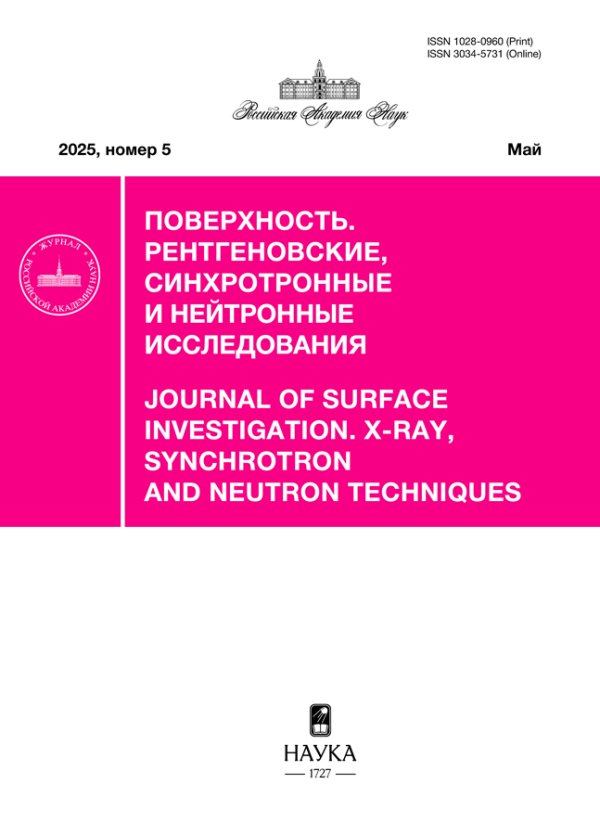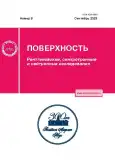Investigation of the Corrosion Properties of Bulk Amorphous Metal Alloys Based on Zirconium
- Authors: Yakovlev A.V.1, Balybin D.V.1, Fedorov V.A.1, Pluzhnikova T.N.1, Fedotov D.Y.1, Shlykova A.A.1
-
Affiliations:
- Tambov State University named G.R. Derzhavin
- Issue: No 9 (2023)
- Pages: 18-24
- Section: Articles
- URL: https://journals.rcsi.science/1028-0960/article/view/137807
- DOI: https://doi.org/10.31857/S1028096023090133
- EDN: https://elibrary.ru/ZMMQTX
- ID: 137807
Cite item
Full Text
Abstract
Corrosion resistance of zirconium-based amorphous alloys in simulating a biological fluid, as well as in aqueous solutions of hydrochloric acid (with HCl concentration 0.1, 0.2, 0.4 mol/L) was studied in this work. When studying the effect of simulating a biological fluid, the samples were exposed to the environment in two ways. In the first case, the sample was completely immersed in a corrosive liquid. In the second case, the sample was subjected to local action of a drop of biological fluid deposited on the surface. It has been established that prolonged exposure to the medium leads to the dissolution of the surface layer of the sample, while the local impact of drops practically does not affect the surface. Preliminary ion implantation of argon and nitrogen ions leads to a decrease in the effect of the biological fluid on the samples. Polarization curves are obtained for all investigated alloys. On the curves obtained during measurements on alloys in simulating a biological fluid, the cathode and anode branches have a standard form. It has been established that the polarization curves for zirconium-based alloys in an aqueous solutions (with HCl concentration 0.1, 0.2, 0.4 mol/l) depend on the elemental composition of the alloys. It has been established that in a sample without copper, the corrosion potential at different concentrations of HCl changes insignificantly. For a sample with a copper content of 15%, the corrosion potential shifts to the cathodic region with an increase in the concentration of hydrochloric acid. The polarization curves of the sample with a higher copper content of 45% are qualitatively different from the curves of the other samples. It is noted that, as in the previous sample, with an increase in the concentration of hydrochloric acid, the corrosion potential shifts to the negative region. It has been established that the corrosion resistance of amorphous alloys based on zirconium, which is the basis of the alloys under study, in the studied solutions increases in comparison with the crystalline one, which is due to the amorphous structure of the electrode material, which complicates the transition of the metal to the ionic state.
About the authors
A. V. Yakovlev
Tambov State University named G.R. Derzhavin
Email: fedorov-tsu.tmb@inbox.ru
Russia, 392000, Tambov
D. V. Balybin
Tambov State University named G.R. Derzhavin
Email: fedorov-tsu.tmb@inbox.ru
Russia, 392000, Tambov
V. A. Fedorov
Tambov State University named G.R. Derzhavin
Author for correspondence.
Email: fedorov-tsu.tmb@inbox.ru
Russia, 392000, Tambov
T. N. Pluzhnikova
Tambov State University named G.R. Derzhavin
Email: fedorov-tsu.tmb@inbox.ru
Russia, 392000, Tambov
D. Yu. Fedotov
Tambov State University named G.R. Derzhavin
Email: fedorov-tsu.tmb@inbox.ru
Russia, 392000, Tambov
A. A. Shlykova
Tambov State University named G.R. Derzhavin
Email: fedorov-tsu.tmb@inbox.ru
Russia, 392000, Tambov
References
- Suryanarayana C., Inoue A. Bulk Metallic Glasses. Boca Raton. CRC Pres. 2017. 542 p. https://www.doi.org/10.1201/9781315153483
- Li H.F., Zheng Y.F. // Acta Biomaterialia. 2016. V. 36. P. 1. https://www.doi.org/10.1016/j.actbio.2016.03.047
- Hua N., Huang L., Chen W., He W., Zhang T. // Mater. Sci. Eng. 2014. V. 44. P. 400. https://www.doi.org/10.1016/j.msec.2014.08.049
- Geissler D., Uhlemann M., and Gebert A. // Corrosion Sci. 2019. V. 159. P. 108057. https://www.doi.org/10.1016/j.corsci.2019.06.012
- Gostin P.F., Eigel D., Grell D., Uhlemann M., Kerscher Eb., Eckert J., Gebert An. // Metals. 2015. V. 5. P. 1262. https://www.doi.org/10.3390/met5031262
- Grell D., Wilkin Y., Gostin P., Gebert A., Kerscher E. // Frontiers in Materials. 2017. V. 3. P. 1. https://www.doi.org/10.3389/fmats.2016.00060
- Wataha J., Lockwood P., Schedle A. // J. Biomed. Mater. Res. 2000. V. 52. P. 360. https://www.doi.org/10.1002/1097-4636(200011)52:2<360: :aid-jbm16>3.0.co;2-b
- Sunderman F. // Fed. Proc. 1978. V. 37. P. 40.
- Liu L., Qiu C., Chen Q., Zhang S. // J. Alloy. Comp. 2006. V. 425. P. 268. https://www.doi.org/10.1016/J.JALLCOM.2006.01.048
- Hiromoto S., Tsai A., Sumita M., Hanawa T. // Corros. Sci. 2000. V. 42. P. 2193. https://www.doi.org/10.1016/S0010-938X(00)00056-1
- Li Y., Zhang W., Dong C., Qiang J., Fukuhara M., Makino A., Inoue A. // Mater. Sci. Eng. A. 2011. V. 528. P. 8551. https://www.doi.org/10.1016/j.msea.2011.07.077
- Zberg B., Uggowitzer P., Lofer J. // Nat. Mater. 2009. V. 8. P. 887. https://www.doi.org/10.1038/nmat2542
- Raju V., Kühn U., Wol U., Schneider F., Eckert J., Reiche R., Gebert A. // Mater. Lett. 2002. V. 57. P. 173.
- Qin C., Asami K., Zhang T., Zhang W., Inoue A. // Mater. Trans. 2003. V. 44. P. 749.
- Pang S., Zhang T., Asami K., Inoue A. // J. Mater. Res. 2003. V. 18. P. 1652. https://www.doi.org/10.1557/JMR.2003.0227
- Inoue T., Zhang J., Saida M., Matsushita M., Sakurai T. // Mater. Trans. JIM. 1999. V. 40. P. 1181. https://www.doi.org/10.2320/matertrans1989.40.1181
- Liu L., Chan K., Pang G. // Appl. Phys. Lett. 2004. V. 85. P. 2788. https://www.doi.org/10.1063/1.1801677
- Liu Y., Wang Y.-M., Pang H.-F., Zhao Q., Liu L. // Acta Biomaterialia. 2013. V. 9. P. 7043. https://www.doi.org/10.1016/j.actbio.2013.02.019
- Huang H.-H., Huang H.-M., Lin M.-C., Zhang W., Sun Y.-S., Kai W. // J. Alloy. Comp. 2014. V. 615. P. S660. https://www.doi.org/10.1016/J.JALLCOM.2014.01.098
- Huang H.H., Sun Y.S., Wu C.P., Liu C.F., Liaw P.K., Kai W. // J. Int. 2012. V. 30. P. 139. https://www.doi.org/10.1016/j.intermet.2012.03.015
- Liu L., Liu Z., Chan K., Luo H., Cai Q., Zhang S. // Scr. Mater. 2008. V. 58. P. 231. https://www.doi.org/10.1016/J.SCRIPTAMAT.2007. 09.040
- Jiang Q., Qin C., Amiya K., Nagata S., Inoue A., Zheng R., Cheng G., Nie X., Jiang J. // Intermetallics. 2008. V. 16. P. 225. https://www.doi.org/10.1016/j.intermet.2007.09.009
- Schroeder V., Ritchie R. // Acta Mater. 2006. V. 54. P. 1785. https://www.doi.org/10.1016/j.actamat.2005.12.006
- Kawashima A., Kurishita H., Kimura H., Inoue A. // Mater. Trans. 2007. V. 48. P. 1969. https://www.doi.org/10.2320/matertrans.mrp2007085
- Kawashima A., Yokoyama Y., Inoue A. // Corros. Sci. 2010. V. 52. P. 2950. https://www.doi.org/10.1016/j.corsci.2010.05.007
- Yokoyama Y., Fujita K., Yavari A., Inoue A. // Philos. Mag. Lett. 2009. V. 89. P. 322. https://www.doi.org/10.1080/09500830902873575
- Иванов М.Б., Ерубаев Е.А., Кузьменко И.Н., Колобов Ю.Р. // Научные ведомости. Серия: Математика. Физика. 2013. № 26(169). Вып. 33. С. 152.
- Улиг Г.Г., Реви Р.У. Коррозия и борьба с ней. Введение в коррозионную науку и технику. Л.: Химия, 1989. 456 с.
- Флорианович Г.М., Ларченко Е.А. // Электрохимия. 1995. Т. 31. № 11. С. 1227.
Supplementary files

















